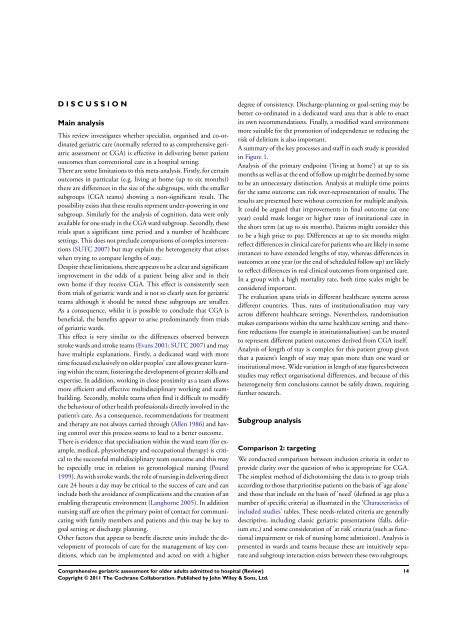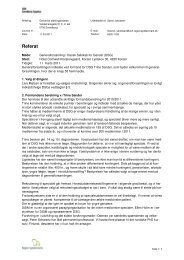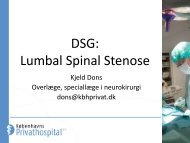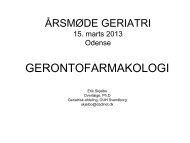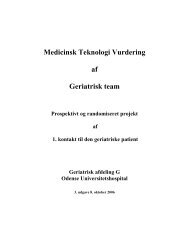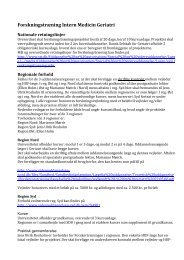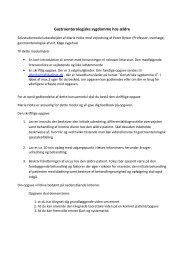Comprehensive geriatric assessment for older adults admitted to ...
Comprehensive geriatric assessment for older adults admitted to ...
Comprehensive geriatric assessment for older adults admitted to ...
Create successful ePaper yourself
Turn your PDF publications into a flip-book with our unique Google optimized e-Paper software.
D I S C U S S I O N<br />
Main analysis<br />
This review investigates whether specialist, organised and co-ordinated<br />
<strong>geriatric</strong> care (normally referred <strong>to</strong> as comprehensive <strong>geriatric</strong><br />
<strong>assessment</strong> or CGA) is effective in delivering better patient<br />
outcomes than conventional care in a hospital setting.<br />
There are some limitations <strong>to</strong> this meta-analysis. Firstly, <strong>for</strong> certain<br />
outcomes in particular (e.g. living at home (up <strong>to</strong> six months))<br />
there are differences in the size of the subgroups, with the smaller<br />
subgroups (CGA teams) showing a non-significant result. The<br />
possibility exists that these results represent under-powering in one<br />
subgroup. Similarly <strong>for</strong> the analysis of cognition, data were only<br />
available <strong>for</strong> one study in the CGA ward subgroup. Secondly, these<br />
trials span a significant time period and a number of healthcare<br />
settings. This does not preclude comparisons of complex interventions<br />
(SUTC 2007) but may explain the heterogeneity that arises<br />
when trying <strong>to</strong> compare lengths of stay.<br />
Despite these limitations, there appears <strong>to</strong> be a clear and significant<br />
improvement in the odds of a patient being alive and in their<br />
own home if they receive CGA. This effect is consistently seen<br />
from trials of <strong>geriatric</strong> wards and is not so clearly seen <strong>for</strong> <strong>geriatric</strong><br />
teams although it should be noted these subgroups are smaller.<br />
As a consequence, whilst it is possible <strong>to</strong> conclude that CGA is<br />
beneficial, the benefits appear <strong>to</strong> arise predominantly from trials<br />
of <strong>geriatric</strong> wards.<br />
This effect is very similar <strong>to</strong> the differences observed between<br />
stroke wards and stroke teams (Evans 2001; SUTC 2007) and may<br />
have multiple explanations. Firstly, a dedicated ward with more<br />
time focused exclusively on <strong>older</strong> peoples’ care allows greater learning<br />
within the team, fostering the development of greater skills and<br />
expertise. In addition, working in close proximity as a team allows<br />
more efficient and effective multidisciplinary working and teambuilding.<br />
Secondly, mobile teams often find it difficult <strong>to</strong> modify<br />
the behaviour of other health professionals directly involved in the<br />
patient’s care. As a consequence, recommendations <strong>for</strong> treatment<br />
and therapy are not always carried through (Allen 1986) and having<br />
control over this process seems <strong>to</strong> lead <strong>to</strong> a better outcome.<br />
There is evidence that specialisation within the ward team (<strong>for</strong> example,<br />
medical, physiotherapy and occupational therapy) is critical<br />
<strong>to</strong> the successful multidisciplinary team outcome and this may<br />
be especially true in relation <strong>to</strong> geron<strong>to</strong>logical nursing (Pound<br />
1999). As with stroke wards, the role of nursing in delivering direct<br />
care 24 hours a day may be critical <strong>to</strong> the success of care and can<br />
include both the avoidance of complications and the creation of an<br />
enabling therapeutic environment (Langhorne 2005). In addition<br />
nursing staff are often the primary point of contact <strong>for</strong> communicating<br />
with family members and patients and this may be key <strong>to</strong><br />
goal setting or discharge planning.<br />
Other fac<strong>to</strong>rs that appear <strong>to</strong> benefit discrete units include the development<br />
of pro<strong>to</strong>cols of care <strong>for</strong> the management of key conditions,<br />
which can be implemented and acted on with a higher<br />
degree of consistency. Discharge-planning or goal-setting may be<br />
better co-ordinated in a dedicated ward area that is able <strong>to</strong> enact<br />
its own recommendations. Finally, a modified ward environment<br />
more suitable <strong>for</strong> the promotion of independence or reducing the<br />
risk of delirium is also important.<br />
A summary of the key processes and staff in each study is provided<br />
in Figure 1.<br />
Analysis of the primary endpoint (’living at home’) at up <strong>to</strong> six<br />
months as well as at the end of follow up might be deemed by some<br />
<strong>to</strong> be an unnecessary distinction. Analysis at multiple time points<br />
<strong>for</strong> the same outcome can risk over-representation of results. The<br />
results are presented here without correction <strong>for</strong> multiple analysis.<br />
It could be argued that improvements in final outcome (at one<br />
year) could mask longer or higher rates of institutional care in<br />
the short term (at up <strong>to</strong> six months). Patients might consider this<br />
<strong>to</strong> be a high price <strong>to</strong> pay. Differences at up <strong>to</strong> six months might<br />
reflect differences in clinical care <strong>for</strong> patients who are likely in some<br />
instances <strong>to</strong> have extended lengths of stay, whereas differences in<br />
outcomes at one year (or the end of scheduled follow up) are likely<br />
<strong>to</strong> reflect differences in real clinical outcomes from organised care.<br />
In a group with a high mortality rate, both time scales might be<br />
considered important.<br />
The evaluation spans trials in different healthcare systems across<br />
different countries. Thus, rates of institutionalisation may vary<br />
across different healthcare settings. Nevertheless, randomisation<br />
makes comparisons within the same healthcare setting, and there<strong>for</strong>e<br />
reductions (<strong>for</strong> example in institutionalisation) can be trusted<br />
<strong>to</strong> represent different patient outcomes derived from CGA itself.<br />
Analysis of length of stay is complex <strong>for</strong> this patient group given<br />
that a patient’s length of stay may span more than one ward or<br />
institutional move. Wide variation in length of stay figures between<br />
studies may reflect organisational differences, and because of this<br />
heterogeneity firm conclusions cannot be safely drawn, requiring<br />
further research.<br />
Subgroup analysis<br />
<strong>Comprehensive</strong> <strong>geriatric</strong> <strong>assessment</strong> <strong>for</strong> <strong>older</strong> <strong>adults</strong> <strong>admitted</strong> <strong>to</strong> hospital (Review)<br />
Copyright © 2011 The Cochrane Collaboration. Published by John Wiley & Sons, Ltd.<br />
Comparison 2: targeting<br />
We conducted comparison between inclusion criteria in order <strong>to</strong><br />
provide clarity over the question of who is appropriate <strong>for</strong> CGA.<br />
The simplest method of dicho<strong>to</strong>mising the data is <strong>to</strong> group trials<br />
according <strong>to</strong> those that prioritise patients on the basis of ’age alone’<br />
and those that include on the basis of ’need’ (defined as age plus a<br />
number of specific criteria) as illustrated in the ’Characteristics of<br />
included studies’ tables. These needs-related criteria are generally<br />
descriptive, including classic <strong>geriatric</strong> presentations (falls, delirium<br />
etc.) and some consideration of ’at risk’ criteria (such as functional<br />
impairment or risk of nursing home admission). Analysis is<br />
presented in wards and teams because these are intuitively separate<br />
and subgroup interaction exists between these two subgroups.<br />
14


